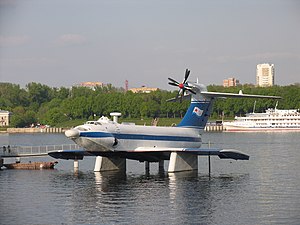A-90 Orlyonok
| A-90 "Orlyonok" | |
|---|---|
 |
|
| A-90 "Orlyonok" in Moscow | |
| Role | Ekranoplan |
| Manufacturer | Central Hydrofoil Design Bureau |
| Designer | Rostislav Evgenievich Alexeyev |
| First flight | 1972 |
| Introduction | 1979 |
| Retired | 1993 |
| Primary user | Soviet Navy |
| Number built | 5 |
The A-90 Orlyonok (Russian: Орлёнок, English: "Eaglet") is a Soviet ekranoplan (a ground effect vehicle) that was designed by Rostislav Evgenievich Alexeyev of the Central Hydrofoil Design Bureau.
The A-90 uses ground effect to fly a few meters above the surface. The Russians classify it as Ekranoplan Class B - it can achieve an altitude of 3,000 m (9,800 ft), placing between Class A - which is limited to ground effect, and Class C, which exploits the ground effect only during take-offs and landings.
The Soviet Navy command of the 1960s was very interested in a fast military transport capable of carrying a large payload. The Central Hydrofoil Design Bureau was one of the organizations working on this top secret project, about which little was known until the fall of the Soviet Union.
Chief Designer R.E. Alexeyev designed several prototypes in the 1960s. At the start of the 1970s, Alexeyev designed a medium-sized Ekranoplan to be used as a military transport. The new vehicle was named "Orlyonok" ("Eaglet"). The first flying unit (S-23) was initially tested on the Volga River in the autumn of 1972, and the next year dismantled and transported to the Caspian Sea for continued testing. In 1975 the S-23 crashed during testing, later proved to be due to a deficiency in the alloy used for the hull. A different alloy was used in all subsequent units built.
The Orlyonok was designed as a transport and also as a beach assault vehicle. Unlike other Soviet Ekranoplan designs, the Orlyonok was amphibious and was equipped with wheels for beaching and land based takeoffs.
The layout of the engines on the Orlyonok was unusual and a testament of the special needs of such an unconventional aircraft. Mounted in the top of the tail, it featured a massive Kuznetsov NK-12 turboprop, the most powerful turboprop ever made, which provided cruise power. The nose of the aircraft mounted two turbofan engines with the intakes on top of the nose and the exhaust along the side of the fuselage, the thrust of these engines being vectored under the wings to produce PAR thrust (increased lift and extra propulsion) for takeoff. Under cruise conditions and in ground effect, the front engines could be shut off since their power was unnecessary to keep the aircraft aloft; this also minimized intake of water, salt and low flying birds.
...
Wikipedia
